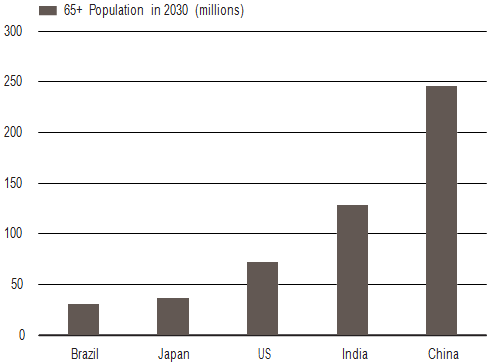
UBS: China’s healthcare sector - Greying population, golden opportunity
China’s healthcare sector is being driven by sustained demand for healthcare services and pharmaceutical products as China’s elderly population rapidly expands and private medical spending increases.
01.03.2018 | 13:28 Uhr
With more than six times the total in Japan and three times that in the US, China’s estimated population of 245.9 million people aged 65+ in 2030 will be the world’s largest, according to UN forecasts. (1)
While the 65+ population will be huge in 2030, it will get there at a rapid rate. 115 million more people will enter the 65+ bracket from 2015 to 2030 and that means annual growth of 4.2%, almost double the 2.3% rate recorded between 2000 and 2015.
Healthcare demand is increasing rapidly
This rapid growth and the sheer size of the 65+ demographic means more cases of age-associated conditions, such as mobility, vision, and hearing impairment, plus a greater number of chronic disease cases, such as diabetes and hypertension, according to the World Health Organizatio. (2)
Taking diabetes as an example, 150.6 million Chinese are expected to have it by 2040, a 37% increase on 2015, and total expenditure on care and treatments will reach an estimated USD 71.8 billion, up from USD 51 billion in 2015, according to estimates by the International Diabetes Federation. (3)
Estimated Population Aged 65+ in 2030 (Millions)
(Source: United Nations Population Division: World Population Prospects 2017)
Public and private spending is growing
China’s government is stepping up investment in healthcare services, with total spending increasing by a factor of five between 2004 and 2014 (4), according to World Health Organization (WHO) data (4), as it has built facilities and increased the supply of medical services.
A further source of demand for healthcare comes from Chinese citizens’ increasing spending on medical services. As incomes rise and healthcare options increase, consumers are spending more on private healthcare, with total private spending growing an estimated 16.4% per year between 2005 and 2014, according to WHO data. (4)
And while the rates of both public and private health expenditure are growing fast, there is still significant room for growth because actual healthcare spending levels in China remain low by international standards, with healthcare spending in estimated at 5.5% of GDP in 2014, compared with 10.2% in Japan, and 17.1% in the US, according to WHO data.
Chinese healthcare companies are innovating to compete
While underlying macro trends are positive for the healthcare sector as a whole, competition is fierce, and that means Chinese companies have to innovate to take a share of the market. Indeed, because of the size of the opportunity, and competition for sales, Chinese companies are boosting their R&D investments to create innovative products.
And this is creating a boom in new and innovative drug patents being produced by Chinese companies. In 2015, Chinese firms registered 855 new pharmaceutical patents (5), up 151.4% compared with 2007 and outstripping growth in other global markets. With recent reforms to speed up patent approval processes, we are expecting a strong pipeline of innovative products in the future.
Strong outlook for China’s Healthcare Sector
So, with China’s growing aged population, plus increasing spending on medical services, the long-term outlook looks strong for China’s healthcare sector. But innovation will be key, since competition is ratcheting up, and only companies with a strong innovative culture will be best set to capitalize on the undoubted opportunities in the sector.
The full article you will finde here.



Diesen Beitrag teilen: